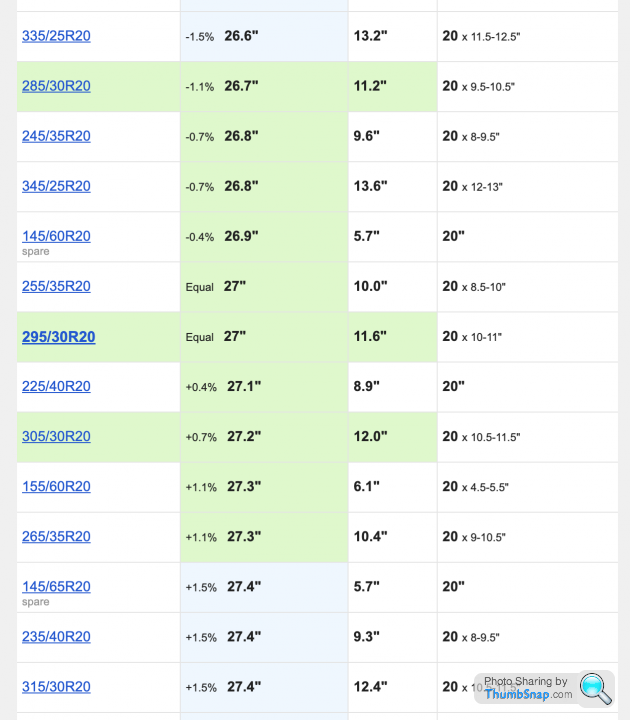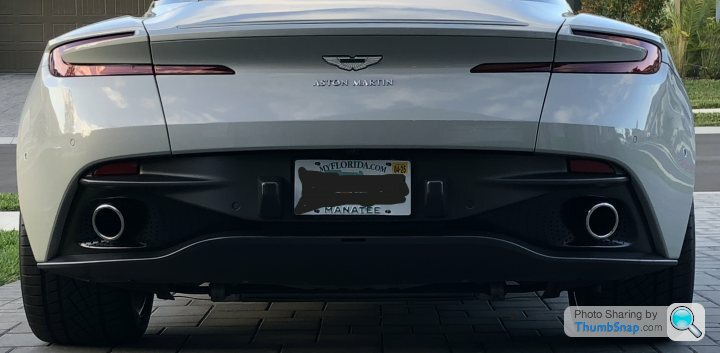Discussion
Has anyone put wider rear tyres than stock on their car? especially those of you that have made performance modifications such that possibility of wheelspin in lower gears increases.
As stock, my DB9.2 has the following:
245/35/R20 Front (20x8.5" wheels)
295/30/R20 Rear (20x11" wheels)
According to this site (https://tiresize.com/tires/Aston-Martin/DB9/2014/Volante-Convertible/) the 11" wide rear wheels could also take 305/30/R20 (shown in green). I see that 315/30/R20 would also fit an 11" wide wheel.

As stock, my DB9.2 has the following:
245/35/R20 Front (20x8.5" wheels)
295/30/R20 Rear (20x11" wheels)
According to this site (https://tiresize.com/tires/Aston-Martin/DB9/2014/Volante-Convertible/) the 11" wide rear wheels could also take 305/30/R20 (shown in green). I see that 315/30/R20 would also fit an 11" wide wheel.

Wide rear tyres aren’t specified primarily for traction. They have more of an influence on steering behaviour, with the aim of reducing twitchy or nervous steering response.
You would gain way more traction by picking really grippy tyres (Conti Sport Contact 7) over maybe other tyres that are 10 or 20mm wider.
You would gain way more traction by picking really grippy tyres (Conti Sport Contact 7) over maybe other tyres that are 10 or 20mm wider.
Kawasicki said:
Wide rear tyres aren’t specified primarily for traction. They have more of an influence on steering behaviour, with the aim of reducing twitchy or nervous steering response.
You would gain way more traction by picking really grippy tyres (Conti Sport Contact 7) over maybe other tyres that are 10 or 20mm wider.
This is very true. It is tire compound, not width that makes a difference on traction. You would gain way more traction by picking really grippy tyres (Conti Sport Contact 7) over maybe other tyres that are 10 or 20mm wider.
The "contact patch" a tire makes is dependent upon the weight that bares on the tire. If you change tire width on the same car, same weight, the "shape" of the contact patch changes, but the sq in of the contact patch stays the same.
skhannes said:
The "contact patch" a tire makes is dependent upon the weight that bares on the tire. If you change tire width on the same car, same weight, the "shape" of the contact patch changes, but the sq in of the contact patch stays the same.
Interesting, like the displacement of a boat.So let's face it, we have wide tyres for the 'cool factor'

Simpo Two said:
Interesting, like the displacement of a boat.
So let's face it, we have wide tyres for the 'cool factor'
Yes - the only other factor besides the weight on the tire is air pressure. Weight and air pressure can increase or decrease traction, but wider with the same weight same pressure and same tire compound yields same results. So let's face it, we have wide tyres for the 'cool factor'

And yes, I do wider for looks. In fact, I've switched the tires on my DB11 V12 to all season as I only use my car as a GT, but I am constantly confronted with surprise downpours in Florida.

The amount of torque, in Newton Metres (T) that can be transmitted by a clutch is limited by several factors:
The number of contact patches. (S)
Pressure applied to contact patch. (P)
The coefficient of friction of the friction disc. (µ)
The mean radius of the contact patch. (r)
This can be summarised as the equation T = SPµr
The same principle applies to tyres. Wider/bigger contact patch does not equate to greater grip/traction capability. Hence you see very skinny tyres on rally cars when on ice. Off road vehicles use slimmer tyres, but also use floatation type tyres on boggy/sandy ground.
Contact area/pressure/coefficient of friction of the rubber all have a vote in grip/traction.
The number of contact patches. (S)
Pressure applied to contact patch. (P)
The coefficient of friction of the friction disc. (µ)
The mean radius of the contact patch. (r)
This can be summarised as the equation T = SPµr
The same principle applies to tyres. Wider/bigger contact patch does not equate to greater grip/traction capability. Hence you see very skinny tyres on rally cars when on ice. Off road vehicles use slimmer tyres, but also use floatation type tyres on boggy/sandy ground.
Contact area/pressure/coefficient of friction of the rubber all have a vote in grip/traction.
The Vanquish II has:
255/35/R20 Front (20x9” wheels)
305/30/R20 Rear (20x11.5” wheels)
So relative to a DB9.2 (below), Vanquish II wheels are 0.5" wider (both front and rear) with tyres 10mm wider (again, both front and rear)
245/35/R20 Front (20x8.5” wheels)
295/30/R20 Rear (20x11” wheels)
Is there sense in a DB9 having slightly wider tyres if having been modified to meet/exceed Vanquish II torque & power numbers?
255/35/R20 Front (20x9” wheels)
305/30/R20 Rear (20x11.5” wheels)
So relative to a DB9.2 (below), Vanquish II wheels are 0.5" wider (both front and rear) with tyres 10mm wider (again, both front and rear)
245/35/R20 Front (20x8.5” wheels)
295/30/R20 Rear (20x11” wheels)
Is there sense in a DB9 having slightly wider tyres if having been modified to meet/exceed Vanquish II torque & power numbers?
Gassing Station | Aston Martin | Top of Page | What's New | My Stuff



